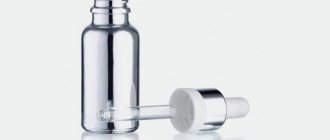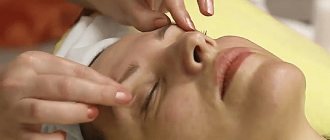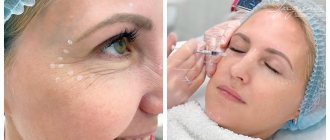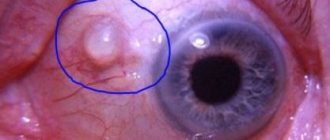Sometimes patches and home decongestants really “don’t work,” and if they do, it’s only as a placebo—after all, sometimes getting rid of “bags” and “circles” under the eyes is not as easy as it seems at first glance. In this material we will tell you why this aesthetic defect occurs in general and what correction methods exist. We talked about this with cosmetologist Natalya Petrovna Ishenina
and have prepared for you an overview of the top and most effective procedures for the beauty of the periorbital area.
Let us immediately note that for some patients, according to individual indications, more radical methods of plastic surgery are indicated to solve the problem, for example, blepharoplasty
. Today this is the most effective way to quickly get rid of “bags” under the eyes forever. We will also talk about in what cases and why plastic surgery blepharoplasty is sometimes most appropriate in the article.
Symptoms of puffy eyes
Experts consider two options for swelling: when the eyelids, conjunctiva, orbits or subcutaneous tissue under the eyes swell. Both or one eye may swell, most often without additional symptoms. Unilateral swelling in the absence of other symptoms is usually not a cause for concern. But if there is severe swelling of the upper and lower eyelids (on one or both sides), it is worth checking your health. Along with swelling, the following symptoms may appear:
- limited vision (especially due to severe swelling);
- profuse lacrimation;
- photophobia;
- feeling of dryness;
- peeling of the skin.
Sometimes, with severe swelling, mucous discharge appears. They may have a sticky consistency, be wet or dried out. Swelling of the eyelids can also be accompanied by pain, redness, and irritation of the mucous membrane.
Causes leading to swelling of the eyes
Short-term swelling, which goes away quickly and independently, is usually not associated with external factors, diseases, or physiology. More often it is caused by the following factors:
- poor nutrition (drinking large amounts of liquid before bed, drinking alcohol, addiction to smoked meats, spicy, salty foods);
- stress;
- cry;
- violation of wearing contact lenses;
- visual stress;
- individual characteristics of the body;
- violation of the work and rest schedule;
- bad habits;
- constant lack of sleep.
Other subjective symptoms of eyelid swelling include a burning sensation, blurred vision, and redness of the sclera. Usually they are persistent and pronounced, which once again confirms the presence of ocular or systemic diseases.
Is there swelling on the face due to heart disease?
Yes, these questions usually worry women, says cardiologist Andrei Grachev.
They run to see a cardiologist when they can’t put a ring on their finger in the morning because it’s swollen or put on makeup because their face is swollen. The patient wants to look great, regardless of age and health status. And this is commendable. Men, as a rule, do not contact a cardiologist with such questions. The peculiarity of this issue is due to the fact that in patients with cardiovascular diseases, as a rule, swelling on the face appears at the final stage of a complication such as heart failure. First, they appear on the legs (the lowest point in relation to the heart), then fluid accumulates in the abdominal cavity, the liver and spleen enlarge (as a blood depot). And only after the fluid reaches the pleural cavities and the heart sac, swelling may occur on the face or hands.
Could swelling be a symptom of an allergy?
An allergic reaction is one of the common causes of swelling. This happens because mast cells release biologically active proteins to neutralize allergens. But when combined with irritants, they cause a reaction that is similar to inflammation. Hence the swelling and redness of the eyelids. Among the ophthalmological causes of eyelid swelling, the most common are:
- glaucoma;
- conjunctivitis;
- periorbital cellulitis;
- eyelid tumors;
- injuries;
- insect bites;
- thermal, chemical burns.
Often the appearance of swelling is the body’s reaction to smoke, dust and other irritants from the external environment.
Why does swelling occur in dry eye syndrome?
Dry eye syndrome (DES) is a pathological condition that is based on a violation of the stability of the tear film.
It provides nutrition, hydration and protection to the cornea. But when few tears are produced or their composition changes, the tear film quickly begins to evaporate. Because of this, the mucous membrane dries out, a burning sensation, itching, redness, and swelling appears.
Various reasons contribute to the development of dry eye syndrome. This could be taking antidepressants, antihistamines, working at a computer for a long time, or staying in a room with dry air. Dry eye syndrome may progress during sun exposure (summer) because too much air temperature causes tears to evaporate.
You can compensate for moisture deficiency with the help of tear substitutes. These are special drops that contain moisturizing components. But, despite the fact that they have a composition close to tears, they do not contain mucins and lipids, which help the tear film to adhere to the surface of the eyeball and maintain stability.
One of the effective ways to restore the tear film is the use of Delfanto® in capsules. They contain a record amount of antioxidants (at least 35%), which help stimulate the production of your own tears.
"Tobrex"
Tobrex drops are familiar to many people. This drug is used for swelling of the eyes, infectious and inflammatory pathologies, and infections of the visual organs. Ophthalmologists prescribe it for conjunctivitis, blepharitis, iridocyclitis, keratitis and other eye diseases. These drops are often used to prevent post-operative infections.
The main active ingredient of Tobrex is benzalkonium chloride. This is an effective antiseptic component that has antifungal and antimicrobial effects. In addition to benzalkonium chloride, the drug contains:
- boric acid;
- sodium chloride;
- sodium sulfate anhydrous;
- sodium hydroxide;
- tyloxapol;
- water.
The dosage regimen for the drug is determined by the ophthalmologist on an individual basis. The use of eye drops is often prohibited. This can lead to headache, asthenia, nausea, anemia and other side effects. The drug should be used with caution in case of kidney disease, pregnancy and lactation. "Tobrex" is a broad-spectrum antibiotic that belongs to the group of aminoglycosides. Eye drops are especially effective against gram-negative bacteria. The drug is available from pharmacies with a prescription. The estimated cost of eye drops is 180-200 rubles per bottle.
What diseases can cause swollen eyes?
This symptom accompanies not only ophthalmological pathologies. It may be associated with systemic diseases. For example:
- gastrointestinal diseases;
- pathologies of the pituitary gland, thyroid gland;
- diseases of the gastrointestinal tract;
- infectious, viral diseases;
- liver and kidney diseases.
The list goes on, because there are more than 70 diseases that are accompanied by swelling of the eyelids. This could indicate problems with almost any organ.
Why does swelling occur?
Swelling above or below the eyes in the morning can be caused by two types of reasons:
- associated with short-term violations of the daily routine ;
- associated with serious internal diseases .
Reasons that do not cause serious concern
These reasons include:
- drinking too much liquid the night before or just before bed;
- drinking alcohol the day before;
- abuse of salted and smoked foods;
- prolonged crying before bedtime ;
- severe eye strain;
- use of inappropriate cosmetics ;
- age-related changes;
- genetic predisposition.
Causes requiring immediate medical attention
Reasons to immediately consult a doctor include various diseases affecting the patient’s kidneys and endocrine system .
It is worth noting! The most common diseases that cause fluid stagnation in the tissues around the eyes are:
- kidney pathologies - in this case, an imbalance of fluids in tissues and internal organs occurs. In addition to swelling of the eyelids in the morning, patients may complain of swelling of the limbs and face. This condition requires examination by a nephrologist and further treatment with special medications;
- pathologies of the endocrine system - in this case, the lesion most often affects the thyroid gland. In addition to swelling of the eyelids, patients may experience an increase in neck volume, excess weight, difficulty swallowing, and changes in voice. The problem is corrected by prescribing hormonal drugs;
- allergic reactions - allergies can bother the patient constantly or worsen during certain seasons. Dust, wool, pollen and much more can act as allergens. The main symptoms of allergies are swelling of the eyelids and eyes in the morning, watery eyes, runny nose and sneezing. Sometimes swelling in the morning can indicate the presence of a food allergy;
- eye diseases - this includes infectious and non-infectious diseases. Most often these include blepharitis, conjunctivitis, stye and scleritis. In this case, in addition to swelling, patients may complain of lacrimation, pain and the formation of purulent contents.
How to remove puffiness under the eyes?
It is difficult to immediately determine the cause of swelling. But you can try to eliminate provoking factors, for example, normalize your daily routine, diet, and get rid of bad habits.
If swelling is persistent, you need to seek medical help. Only a specialist can determine the reason why the eyelids are swollen and prescribe therapy.
If there is reason to believe that swelling of the eyelids is associated with everyday factors (crying, working at the computer, sleep disturbances, etc.), you can try to cope with this problem yourself. For example, using cold compresses. Cold causes blood vessels to contract, which reduces swelling.
Sometimes chilled tea bags can help relieve swelling quickly. Tea contains caffeine, which helps remove excess fluid from tissues. Tea bags must be applied for 15-20 minutes.
You can also try to remove swelling with massage (10-15 minutes a day). You also need to get good rest. Sleep should last at least 7 hours a day, and it is advisable to go to bed at the same time.
If swelling still periodically reminds itself, then you need to seek help from a specialist. Early detection of pathologies that cause swelling of the eyelids helps prevent serious complications.
If swelling is accompanied by a burning sensation, dry eyes, itching, irritation, you should take Delfanto® capsules regularly. They help increase the production of tear fluid by 89%, due to which the cornea and conjunctiva receive natural hydration.
Common drugs
Among diuretic tablets, drugs that do not have a strong diuretic effect are recommended.
This is a non-specific treatment, and similar drugs are used for problems of the urinary system, therefore, for edema, drugs of average effectiveness are preferred:
- Cyclomethiazide . The product begins to act within an hour after administration and promotes the rapid removal of excess fluid from the body. But it is characterized by a large number of side effects, including intestinal disorders, removal of sodium and chlorine from body tissues, and lowering blood pressure. The recommended dose is one piece per day in the morning.
- Hypothiazide. It stimulates urinary processes, but potassium is excreted in large quantities along with urine. Therefore, therapy using such tablets is combined with taking drugs containing potassium. The maximum effect is observed three hours after administration. You can take no more than two tablets per day.
- Veroshpiron . One of the least toxic drugs in the diuretic group. Side effects of this drug include loss of sensation in the fingers and drowsiness. It is better to take the drug once every two to three days, one piece per day.
- Triamterene . When taking this drug, potassium is not removed from the body. The peak effect of the drug occurs in the first hour after use. The permissible dose for eliminating bags and bruises is no more than one tablet per day and no longer than three weeks.
- Spironolactone . A slow-acting drug whose effectiveness increases over several days of treatment. It has a small number of side effects. You can take the medicine up to four times a day.
For swelling caused by allergies , you can take antihistamines.
One of them is zodak , which can be used to eliminate edema in adults and children.
Note! This is a long-acting drug that additionally relieves itching associated with allergies and eliminates signs of irritation.
At the age of six to twelve years, it is allowed to take one tablet per day, but it must be divided into two parts and given one of them in the morning, and the second in the evening.
The adult dosage, which is also allowed for the treatment of children over 12 years of age, includes taking one whole tablet once a day.
Another antiallergic drug that eliminates swelling is the medicine Cetrin .










